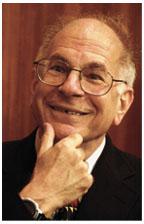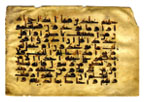November 6, 2002: Notebook

 Economics
Nobel goes to Daniel Kahneman
Economics
Nobel goes to Daniel KahnemanProfessor of psychology and public affairs wins for his work on decision-making and risk
Photo: Professor of Psychology Daniel Kahneman was all smiles at the press conference where he talked about his work and winning the 2002 Nobel in economics. (Frank Wojciechowski)
How much is a coffee mug worth? It all depends on if you actually have one. Take a roomful of people, only half of whom are given a mug to take home. The mug owners are asked how much money they would demand to give up their mugs; the others are asked what they would pay to acquire them. In the end, the mug owners estimate the value of the mug to be about double what the non-mug owners say they are worth.
Rational? Maybe not, but that’s the point. Studies like this one, demonstrating that people respond differently to a proposition depending on whether it is presented in terms of a loss or a gain, are part of the 30 years of work that earned Princeton psychology professor Daniel Kahneman the 2002 Nobel Prize in economic sciences on October 9. Kahneman, also a professor of public affairs at the Woodrow Wilson School since he arrived at Princeton in 1993, shares the award with Vernon Smith, a professor of economics and law at George Mason University. The two will split the $1-million award that comes with the prize.
Kahneman learned of the honor at 9:15 that morning, when he took a phone call from someone “with a distinct Swedish accent,” he recounted later. The caller told him the happy news and then explained how Kahneman could verify the call to ensure that he was not the victim of a nasty prank.
Several hours later at an afternoon press conference (www.princeton.edu/ webmedia), President Tilghman introduced Kahneman to an overflow crowd in Dodds Auditorium. The Nobel laureate gave an embarrassed grin and ducked his head as he took the podium to warm and sustained applause. Looking at the crowd of journalists, students, and colleagues, he turned to Tilghman and asked, “How do we do this?” As it turned out, he did not require much help.
Although he was honored with the economics prize, Kahneman admitted that he had never taken an economics course and shot down questions from reporters looking for his insights into business or money-specific topics. “Give me a break,” he said to one reporter asking a particularly detailed question on consumer buying habits. “I’m a psychologist. I happen to work with economists as collaborators. I don’t view myself as an economist. If anything, I am a psychologist with fairly broad interests,” he explained.
Economists have long believed that people will be rational when they make decisions about their money. But during the last 50 years, researchers like Kahneman have been chipping away at that assumption, seeking to introduce evidence from experiments in the fields of cognitive psychology and behavorial economics that demonstrate the role emotions and other biases play in decision-making. In honoring Kahneman, the Royal Swedish Academy of Sciences gave more credence to this burgeoning field of economic research.
“Daniel Kahneman has integrated insights from psychology into economics, thereby laying the foundation for a new field of research. . . . His work has inspired a new generation of researchers in economics and finance to enrich economic theory using insights from cognitive psychology into intrinsic human motivation,” the academy said.
“What he got the prize for is not so much a specific piece of information, but for changing the ways in which people think about some important issues,” said Princeton economics professor Michael Rothschild, former dean of the Woodrow Wilson School. “It took a long time for this work to have much of an effect on economics. People knew it was around, and they knew it was true, but they did not know how to use it. Now it’s being used in many ways.”
Kahneman has been praised for years for the research he started in 1969 with his friend Amos Tversky, who died in 1996. Although the pair trained together as cognitive psychologists at the Hebrew University in Jerusalem, their research into deviations from rationality has been influencing economic theory since their article “Prospect Theory,” which examined decision-making under risk, appeared in the economics journal Econometrica in 1979. Since then, the article has become the most cited piece ever to run in the 69-year-old publication.
Kahneman speculated that he would not have won the Nobel Prize “if exactly the same paper had been published in a psychological journal. Because it was published in an economics journal, it had a fair amount of influence on the profession, and it sort of legitimized a certain approach to thinking about decision-making, which eventually, through the work of other economists, became influential in economics itself.”
During the press conference, Kahneman, who is 68, credited his collaborations with Tversky, who worked at Stanford University, and mourned his absence. “Certainly we would have gotten this [Nobel] together, and that’s one of the things that this means to me today. There is that shadow over the joy I feel,” he said.
The pair’s landmark work explored decision-making in various scenarios, including gambling. They found that people set reference points from which they judged their gains and losses and ended up focusing more on deviations from their reference points than on the overall result.
For instance, if a gambler is losing steadily, the risks that gambler would take to try to win back his losses and break even are greater than the risks he would take to gain the same amount of money had he been winning all along. Kahneman’s research shows that people are disproportionately interested in what they might lose rather than what they might gain.
“He’s a scientist of the first rank,” said Princeton economist Alan Krueger, who is working with Kahneman on studies investigating well-being and what people believe makes them happy. “He has very, very strong intuition. I think he’s learned from his work that people tend to be too overconfident in their own conclusions, closed-minded. When you think of a social scientist, he should be the model that comes to mind. He’s willing to entertain almost any idea.”
Since he arrived at Princeton, Kahneman has introduced hundreds of students to psychology by coteaching Introduction to Psychology. He also has played an important role in preparing students at the Woodrow Wilson School for careers in public policy, Rothschild said.
“I was convinced that when you’re educating very bright students you’re not filling vessels with knowledge, you’re providing intelligent workmen with good tools,” he said. “It seemed to me that the tools in Kahneman’s work ought to be part of the toolbag of an intelligent public servant.”
The last member of Princeton’s faculty and research staff to win the Nobel Prize in economics was senior research mathematician John Nash *50, who won in 1994. With Kahneman’s selection, there are currently nine faculty and research staff members at Princeton who have won a Nobel Prize. Kahneman will receive his prize during ceremonies December 10 in Stockholm.
Born in 1934 in Tel Aviv, Israel, Kahneman is the first Israeli to win the Nobel Prize in economics. His family later moved to France, where they lived during the German occupation. They fled to Vichy and managed to avoid deportation by hiding in the countryside.
He has dual citizenship in the U.S. and Israel and is married to Anne Treisman, the James S. McDonnell Distinguished University Professor of Psychology at Princeton.
Despite the hoopla, recognition, and money associated with the Nobel,
the award did not come with the coveted gift that Berkeley gives to its
laureates: “a parking spot,” Kahneman said with a grin. So at
the champagne reception that followed the press conference, new Woodrow
Wilson School Dean Anne-Marie Slaughter ’80 presented him with a
permit for one of the parking spaces in the circle in front of Robertson
Hall. ![]()
By A.D.


Nine new members of the Board of Trustees were named in June. They are: Stephen A. Oxman ’67, a charter trustee named for a 10-year term; Kathryn Hall ’80, Preston Haskell ’60, Mellody Hobson ’91, Neil L. Rudenstine ’56, and Paul Sarbanes ’54, all elected by the board to four-year terms as term trustees; and Charles H. Brown ’02, Martin P. Johnson ’81, and James A. Leach ’64, elected by alumni to four-year terms.
Charles H. Brown majored in history with certificates in African-American studies and human values, writing his thesis on race relations in Liverpool, England, after World War II.
Kathryn Hall is president and chief investment officer of Offit Hall Capital Management, a San Francisco-based investment firm. Hall has served Princeton as a board member of the Princeton Investment Co.
Preston Haskell is founder and head of The Haskell Company, an architectural, engineering, and construction firm. He was a board member from 1996 to 2000.
Mellody Hobson is president of Ariel Capital Management, Inc./Ariel Mutual Funds and was instrumental in building the nation’s first black-owned mutual fund group.
Martin P. Johnson is president of Isles, Inc., a Trenton-based nonprofit community development organization that also provides research opportunities for Princeton students and faculty.
James A. Leach is in his 13th term as a member of the House of Representatives from Iowa. A leader of the Republican Party, Leach has served as chair of the Committee on Banking and Financial Services, the Committee on Financial Services, and the Subcommittee on East Asia and the Pacific of the Committee on International Relations.
Stephen A. Oxman was assistant secretary of state for European and Canadian affairs in the first Clinton administration and also served in the Carter administration. He is a senior adviser at Morgan Stanley Dean Witter & Co.
Neil L. Rudenstine is a former president of Harvard and Princeton’s former provost. He now serves as chair of a major nonprofit organization, ArtSTOR, which will develop, maintain, and distribute digital resources for the study of art, architecture, and related fields in the humanities. He teaches at Princeton this semester.
Paul Sarbanes has represented Maryland in the U.S. Senate since 1976. Chair of the Maryland congressional delegation, Sarbanes, a Democrat, serves as chair of the Senate Committee on Banking, Housing and Urban Affairs and is a member of the Joint Economic Committee, the Senate Foreign Relations Committee, and the Senate Committee on the Budget.
The board is responsible for the university’s finances and funds.
It approves the operating and capital budgets, supervises the investment
of the endowment, and oversees all campus real estate and long-range physical
planning. The trustees also review and approve changes in major policies,
tuition and fees, and the hiring of faculty members.
![]()

 In
memoriam
In
memoriam
Photo: princeton communications
Professor of History, Emeritus, Richard Challener ’44 died of cancer on September 23. He was 79.
Joining the Army in 1943, he served until 1946 and was awarded the Combat Infantry Medal and the European Theatre Medal. In 1984, he received the Distinguished Civilian Service Award from the Army.
After the war, Challener returned to Princeton and graduated in 1947. He joined the history department as an instructor in 1949 and earned his Ph.D. from Columbia in 1952. He became a professor in 1964 and retired in 1993, but continued to teach for another seven years as a professor, emeritus. He taught courses in American diplomatic history, 20th-century American history and Canadian history, and he was an expert on Secretary of State John Foster Dulles ’08 and his era.
“Dick Challener was a splendid and supportive colleague, a devoted institutional citizen, and a wonderfully stimulating teacher who engaged, challenged, and widened the intellectual and personal horizons of generations of Princeton students,” said Nancy Weiss Malkiel, professor of history and dean of the college.
“Losing him at a moment when America’s relationship to the rest of the world is of such pressing public concern is especially poignant; his warmth and humanity, his balanced judgment, and wise insight will be sorely missed,” she said.
For more than a decade, Challener and Malkiel cotaught U.S. History
from 1945 to the Present. The course was extremely popular, regularly
attracting more than 300 students. ![]()

Graduate students have complained for years that the university classification ET/DCC — Enrollment Terminated/Degree Candidacy Continued — was akin to falling off a cliff. Starting this month, a temporary safety net will be created: Those who have finished their studies but not yet earned their Ph.D.s will have a one-year grace period with some extended student benefits.
The new status, DCC or Degree Candidacy Continued, recognizes that most graduate students do not complete their dissertations within the time limit, usually five years, that Princeton sets.
Among the benefits DCC status will include are having a university ID card, the ability to extend student health coverage, access to athletic facilities at faculty/staff rates, and parking privileges. Students also will be included on e-mail lists and receive university postings.
In May, President Tilghman charged a committee headed by Provost Amy Gutmann to make recommendations for postenrolled candidates that would, without increasing the time to earn a degree, reduce the hurdles these students face.
The committee made two other recommendations now being implemented. A handbook for DCC students will outline policies and procedures on postenrollment status. Also, Dean of the Graduate School William B. Russel and associates are visiting each academic department to identify best practices that keep graduate students on track for their degrees. Among the practices identified so far are well-defined benchmarks throughout a course of study, and active, committee-based advising.
“The abrupt termination of graduate students at the end of their enrollment has been a sore point since I came to Princeton in 1974,” says Russel.
Students who go beyond the one-year DCC timeline still will face the
problems graduate students have complained hamper them. But Scott Miller,
chair of the Graduate Student Government, is encouraged: “This is
the first forward step I’ve seen since the GSG started working on
this issue. At least it’s now on the administration’s radar
screen.” ![]()


Still Life with Carafe, Bottle, and Fruit is one of 16 Cézanne
watercolors on exhibit at the Art Museum through January 12. The paintings,
from the collection of Henry and Rose Pearlman, have been on loan to the
university since 1976 but rarely have been displayed. Along with the watercolors,
several related paintings and drawings by Cézanne and a sketchbook
page, lent by the Philadelphia Museum of Art, are being shown. A related
exhibit, “Earth’s Beauty Revealed,” examines the 19th-century
European landscape. For more information about the exhibits and other
activities, visit the museum’s Web site: www.princetonartmuseum.org
![]()

 IN
brief
IN
brief
Photo: A 9th- or 10th-century leaf of the Qur’an in Kufic script from the William J. Trezise Collection of Arabic Calligraphy. (princeton archives)
David Botstein has been named the new director of the Lewis-Sigler Institute for Integrative Genomics. He succeeds President Tilghman, who was the founding director, and James Broach, who is interim director. Botstein’s appointment begins July 1, 2003.
Established in 1999, the institute’s mission is to build on the recently completed genome projects and investigate how networks of genes work together to create complex biological systems.
Botstein, who is currently at Stanford University, has made fundamental contributions to modern genetics, including the discovery of many yeast and bacterial genes and the establishment of key techniques that are commonly used today. In 1980, Botstein and three colleagues proposed a method for mapping genes that laid the groundwork for the Human Genome Project.
William J. Trezise, a New York businessman, has donated to the university his collection of Arabic calligraphy, several pieces of which are on display at Firestone Library. The collection contains more than 100 leaves from handwritten copies of the Qur’an dating from the ninth to the 19th century. The university holds more than 11,000 manuscripts in Arabic, Persian, Ottoman Turkish, and other languages of the Islamic world.
Irving Dilliard, a former Ferris professor of journalism with the Council of the Humanities, died in Missouri on October 9, of leukemia. He was 97. A newsman vitally interested in the Constitution and civil rights, Dilliard wrote more than 1,000 editorials for the St. Louis Post-Dispatch. In 1949 he became the newspaper’s editorial page editor and retired from there in 1960. He taught at Princeton from 1964 until 1973. “He was one of America’s great citizens, in that he believed in the institutions of government,” said Lanny Jones ’66, a former student and former editor of PAW, People, and Money magazines. “He was an inspiring individual because of his beliefs. He really lived and breathed the Constitution of the U.S.”
Clayton Marsh ’85 has joined the Office of General Counsel at Princeton. Clayton, a 1997 graduate of the University of Michigan Law School, has been practicing law in New York City. Prior to entering law school Clayton was a member of the faculty at the Lawrenceville School for seven years, he has a master’s from Stanford and a Ph.D. from Columbia.
Arts Alive, created last year and funded by the university to provide
cultural experiences for more than 10,000 schoolchildren affected by the
September 11 terrorist attacks, has expanded its outreach to include students
in New Jersey. Last month, 15 Princeton undergraduates, trained as docents,
took about 130 students from Hoboken and Jersey City schools to tour the
Newark Museum. In New York City, some 50 undergraduates took 400 children
to the American Museum of Natural History.
![]()
